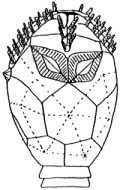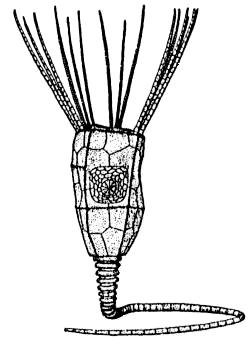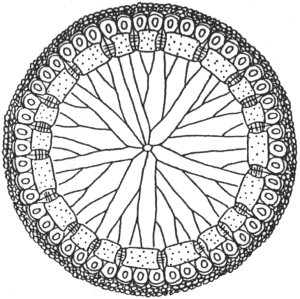
Some WEIRD
ECHINODERMS
of the CINCINNATIAN

Echinoderms are one of the most diverse groups of marine animals that today includes starfish and sea urchins. Most members of the phylum have five-part symmetry, although there is some variation. Echinoderms had a flowering of diversity in the Early Ordovician, and worldwide there are more than 21 classes known. In the local Cincinnatian, however, there is a surprisingly low diversity with only seven classes present, including crinoids, edrioasteroids, starfish, brittle stars, Glyptocystitid Rhombiferans, stylophorans, and cyclocystoids. Crinoids and edrioasteroids are familiar to most local fossil collectors and are relatively common fossils in this area. Although rare, starfish and brittle stars are common in the oceans today. Glyptocystitid rhombiferans, stylophorans, and cyclocystoids, however, are very rare fossils locally and a sharp eye should be kept out looking for them.
All echinoderms have a skeleton composed of a large number of elements called plates, and each plate is a single crystal of the mineral calcite. When the animal dies, these plates tend to fall apart, leaving a pile of debris. Generally, if one finds a whole echinoderm, it must have been preserved by being buried alive. The body is typically called a theca and the animals feed with "arms" called ambulacra.
 |
Glyptocystitid rhombiferans, commonly called cystoids, are common fossils locally in the Cincinnatian. They are characterized by a body, or theca, that has 19-20 plates, long thin feeding appendages called brachioles arising from the ambulacra, and a short flexible stem. Typically, only the theca is found as the brachioles and the stem quickly fall off after death of the animal. |
 |
This glyptocystitid is known from several hundred specimens found mainly in the Upper Whitewater Formation and Elkhorn Formation. It is a small glyptocystitid characterized by very weak ridges on the thecal plates, five diamond-shaped series of holes called "pore rhombs", and long ambulacra that extend onto the theca. |
 |
Cheirocystis fultonensis was described only recently. Previously, this glyptocystitid had been known for many years from only a few disarticulated plates. It is characterized by a large number of diamond-shaped series of holes called "pore rhombs" and plates with large ridges. This species is known only from a few beds in the Point Pleasant Formation and Lower Kope Formation. |

Zygocycloides magnus
Cyclocystoids are one of the rarest of Cincinnati's echinoderms. They are characterized by a ring of heavy plates that have small bumps around the outside and a middle portion that has radial lines. Unfortunately they are small (about the size of a penny) and delicate. Typically all one finds preserved is the ring of plates.
Although there are more than five species of cyclocystoids in the Cincinnatian, the most common is Zygocycloides magnus characterized by having a ring of 20 plates that alternate two big, two small.
Click here for PICTURES of commonly found plates of Zygocycloides magnus.
|
|
Stylophorans are one of the rarer echinoderms in the Cincinnatian. Unlike most other echinoderms, they have one ambulacrum instead of five. Stylophorans are characterized by a feeding/locomotory appendage called an "aulacophore" and a somewhat flattened body. Opposite the aulacophore are two antenna-like appendages of unknown function. Although rare, two species are known from the local Cincinnatian: Enoploura balanoides and Enoploura popei, and locally isolated plates can be extremely abundant. |
![]()
Related Topics
![]()
Photo Gallery of Weird Echinoderms
See Photos of Weird Echinoderms Found on Field Trips
Edrioasteroids of the Cincinnatian
Back to Dry Dredgers Home Page
The Dry Dredgers and individual contributors reserve the
rights to all information, images, and content presented here. Permission to
reproduce in any fashion, must be requested in writing to admin@drydredgers.org .
www.drydredgers.org is designed and maintained by
Bill Heimbrock.